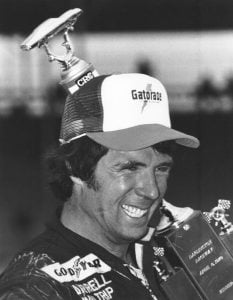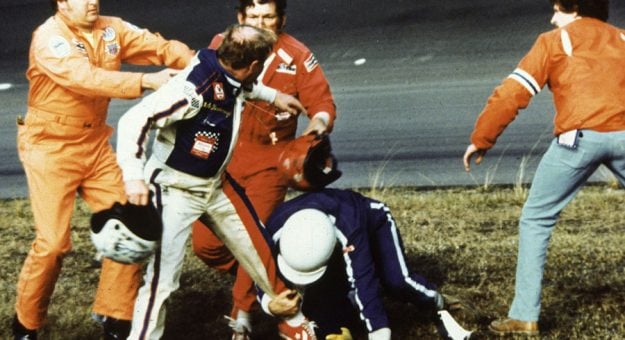Editor’s Note: NASCAR is celebrating its 75th anniversary in 2023. SPEED SPORT was founded in 1934 and was already on its way to becoming America’s Motorsports Authority when NASCAR was formed. As a result, we will bring you Part 32 of a 75-part series on the history of NASCAR as told in the pages of National Speed Sport News and SPEED SPORT Magazine.
Call it the biggest coming-out party in history.
When CBS agreed to televise the 1979 Daytona 500 live, from flag-to-flag, network executives knew they were risking more than the $500,000 paid for the broadcast rights. No one had ever televised a 500-mile race nationally in its entirety before, not even the Indianapolis 500.
Many media experts predicted limited viewership outside of the Southeastern United States with low overall ratings of between 2 and 5. Some felt viewers would not sit through a complete stock car race. What no one predicted was how the race would end.
“There’s a fight on the backstretch! There’s a fight on the backstretch!” screamed CBS announcer Ken Squier after Richard Petty captured his record sixth Daytona 500 crown.
The CBS cameras quickly panned from the No. 43 Oldsmobile to the two drivers who had led the field down the backstretch of the final lap, but were now swinging wildly at one another in the infield.
The fracas erupted after then-race leader Donnie Allison cut off Cale Yarborough as he attempted to go under Allison for the lead on the backstretch. Allison went low and forced the No. 11 Oldsmobile into the grass and Yarborough retaliated by forcing the No. 1 Oldsmobile into the turn three wall.
Once the cars came to a rest in the infield, Allison scrambled from his cockpit shouting obscenities at Yarborough, who yelled back and swung at his rival from his cockpit. The argument escalated when Bobby Allison stopped at the scene and was hit in the mouth by Yarborough’s race helmet. The televised two-on-one fist fight was broken up by onlookers.
“I knew it (the attempted pass) was coming,” explained Donnie Allison. “Cale had in his mind be would pass me low and I had in my mind he would pass me high.”
“If they don’t suspend them, there ain’t no justice in NASCAR,” stated Yalborough. “Bobby waited on us so he could block me off. They double-teamed me. It was the worst thing I’ve ever seen in racing.”
Bobby Allison denied intentionally setting a pick for Yarborough, then his brother fired back at Yarborough: “I towed him back from where he was (three laps down after a lap-32 run-in among the three drivers). I let him get the laps back … he ain’t got no damn halo over his head. He wasn’t fixing to back off and I wasn’t fixing to back off.”
Daytona 500 Telecast Earns 10.5 Overall Rating
Yet, the most dramatic Daytona 500 finish since Pearson and Petty’s last-lap crash in 1976 was not what made the 21st annual race so important.
Despite a 20-minute rain-delayed start, the telecast earned an incredible 10.5 overall rating, with a 13.5 for the final half-hour: In other words, 15 million people saw Petty win his first race since the 1977 Firecracker 400. NASCAR had officially arrived.
“I’ve got to thank God, Gatorade and Goodyear for the way we ran today. All it took was the car owner’s money, the crew’s hard work and my talent,” said Darrell Waltrip after winning the Winston Western 500 at Riverside Int’l Raceway.
Waltrip’s self-acknowledged talent behind the wheel of the Gatorade-sponsored Oldsmobile made 1979 his coming out year as well. After he won the initial race of the Winston Cup season, Waltrip rode Petty’s bumper across the Daytona 500 to solidify his point lead over defending champion Yarborough.
Waltrip beat Petty for his second victory of the season when he passed the six-time champ going into turn four of the final lap of Darlington Raceway’s Rebel500. The No. 43 Monte Carlo led the No. 88 car under the white flag, but Waltrip took the lead in the first tum before Petty retook the point on the backstretch.
This set up Waltrip’s dramatic pass in “Wanda,” the car he drove in his first victory of the season.
Waltrip was also behind the wheel of “Wanda” as he won the World 600 at Charlotte Motor Speedway in front of 135,000 fans.
The following week, Waltrip ended the day in victory lane in the first Winston Cup race at Texas World Speedway since 1973. “Bertha” won her first race of the season —Waltrip’s fifth — at Nashville Fairgrounds Speedway, but “Wanda” was back in victory lane at Talladega (Ala.) Superspeedway.

Waltrip won again at Bristol (Tenn.) Motor Speedway on Aug. 29 and held a 100-point lead over Petty with nine races remaining.
Many observers felt Petty was slowing down after going winless in 45 straight races prior to his Daytona 500 victory. Petty started the season in the much the same manner he ended too many races the previous season.
He finished 32nd on the Riverside after losing his engine on the 14th lap. However, his Daytona victory propelled him to fourth in the points.
Six consecutive weeks of frustration, including a three-foot loss to Bobby Allison at North Wilkesboro (N.C.) Speedway, suggested “The King” had abdicated for good, but he still had much to prove.
At the same time, a new driver was making his presence felt on the circuit. Dale Earnhardt piloted Rod Osterland’s Buick and Monte Carlo for his first full season in Winston Cup.
Earnhardt took fifth in the controversial Daytona 500 and fourth at North Wilkesboro, N.C., before shocking his competitors with a victory at Bristol. The 27-year old’s victory was the first for a Winston Cup rookie since 1974.
Earnhardt’s strong first season included the victory, 11 top-five finishes and 17 top-10 runs. His Monte Carlo even earned the 30th annual Southern 500 checkers with David Pearson behind the wheel while Earnhardt recovered from a crash at Pennsylvania’s Pocono Raceway.
Earnhardt earned the First National City Travelers Checks Rookie Of The Year award over Joe Millikan, Terry Labonte and Harry Gant.
Meanwhile, the old pro continued his step-by-step climb to the title.
“I don’t think I’m making a comeback,” said Petty after his 15th career victory at Martinsville (Va.) Speedway put him in the championship race to stay. “I don’t think I’ve been anywhere.”
While Waltrip drove well in the final third of the season, he only earned one victory and six top-10 finishes. Petty, on the other hand, finished in the top 10 in each of the final 11 races, including victories at Michigan Int’l Speedway, Dover Downs Int’l Speedway and North Carolina Motor Speedway, after which he took the point lead for the first time all season.
However, Waltrip drafted behind Bobby Allison to catch and pass Petty at Atlanta Motor Speedway and retook the championship lead by two points.
L.A. Times 500 Decides ’79 Championship
This left Ontario Motor Speedway’s L.A. Times 500 as the deciding race.
Waltrip started 10th, but a 38th-lap spin put him one lap down and he never made up the difference. A fifth-place finish gave Petty his seventh Wmston Cup title by 11 points.
“I came with all my hopes and I’m leaving with a broken heart,” said Waltrip, also known as “Jaws.” “I got right back on the track (after he spun to avoid John Rezek’s crash) and I was still on the same lap with the leaders, I know I was. After that the only thing I could do was play it safe, stay out of trouble and hope something happened.”
At the conclusion of the season, Petty headed a list of champions which included late model sportsman pilot Gene Glover, modified driver Richie Evans and Winston West competitor Bill Schmitt.
The baby grand division went to Larry Hoopaugh and Harmon (Beaver) Dragon won the NASCAR North title.
